Assessment on Vietnamese-English translation of object labels at Vietnamese women’s museum through foreign tourists’ perspectives
Abstract: Translation of culture-Specific items has posed many difficulties to translators as it requires thorough knowledge of both languages and cultures. This study aims to investigate the assessment of foreign tourists on the translation of object labels at Vietnamese Women’s Museum and to shed light on tourist’s preferences for cultural word translation procedures. In order to fulfil these objectives, a mixed-method research was conducted in which questionnaire and interview were used as the primary data collection instruments. The model proposed by Vinay and Darbelnet (2000) was applied to analyze the procedures of the cultural word translation. The findings showed that the translation at Vietnamese Women’s Museum generally came up to tourists’ expectation and successfully helped them understand the majority of Vietnamese culture exhibited at the museum. However, some contents relating to religion or Vietnamese customs such as Mother worshipping, consecration ritual, 13 celestial Mothers full-month ceremony and traditional outfits such as fabric-making or fabric-dyeing methods, names of traditional costumes caused some challenges to the readers. Suggestions from tourists were valuable for both translators and the museum to improve their translation and display at the museum
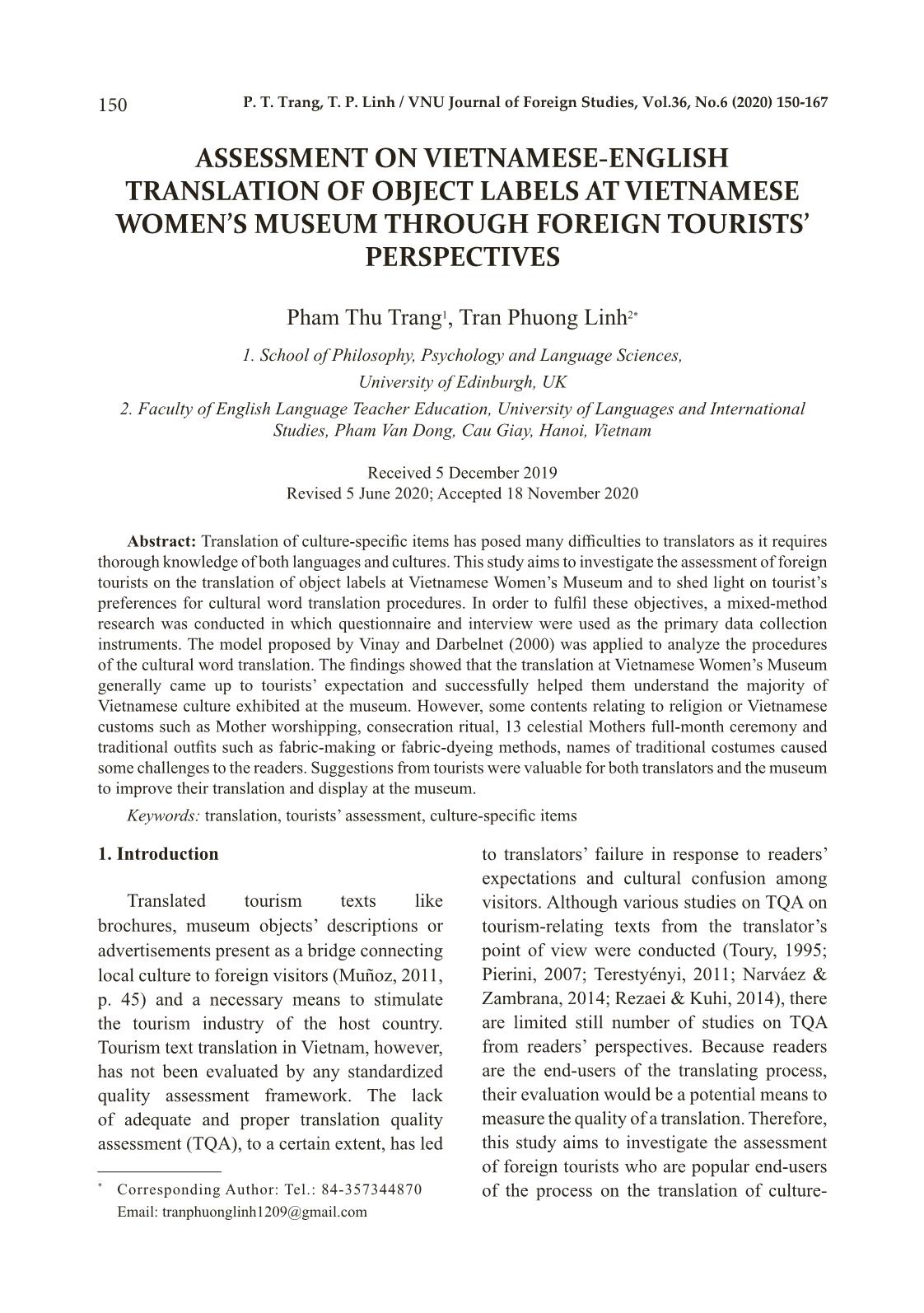
Trang 1
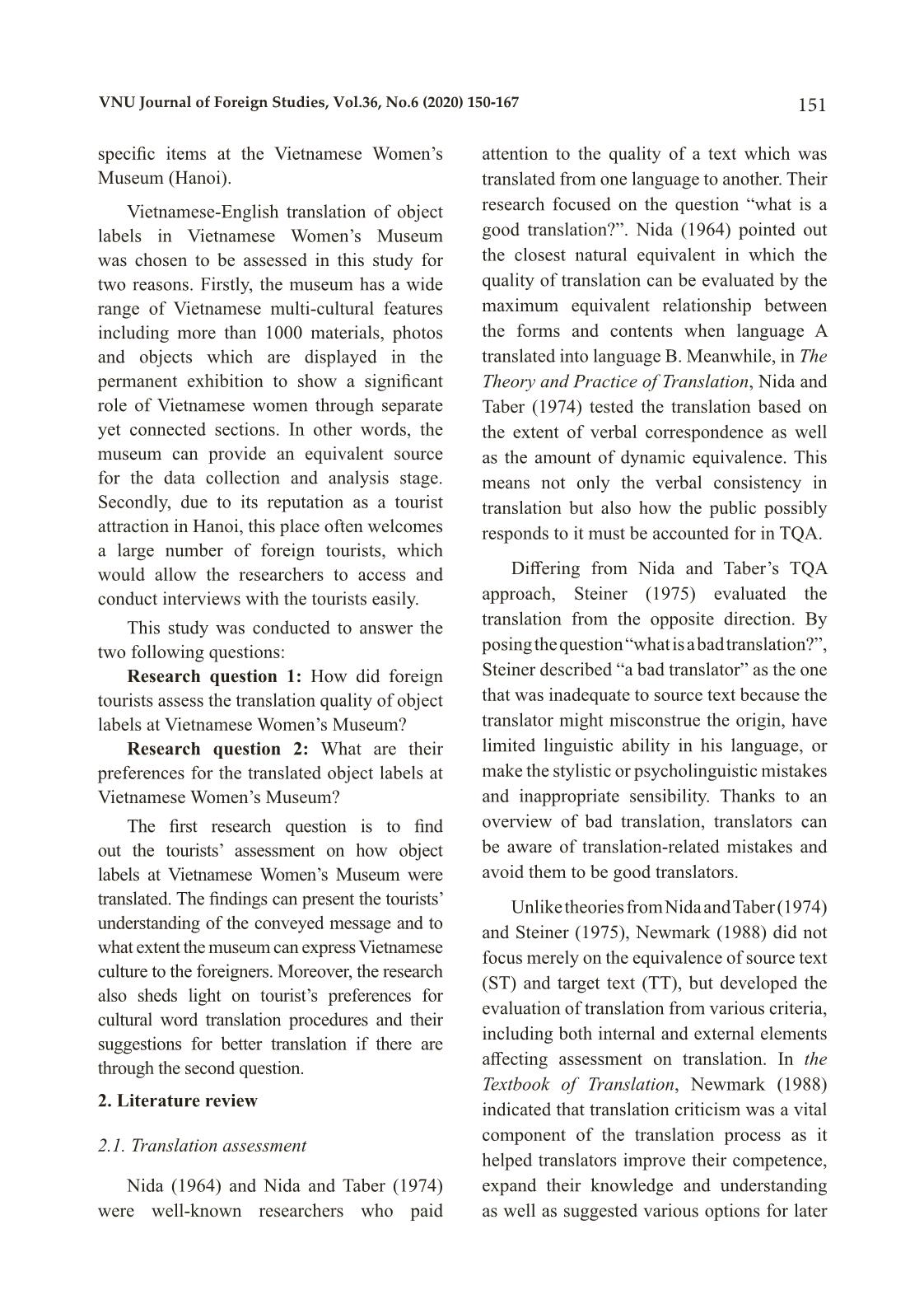
Trang 2
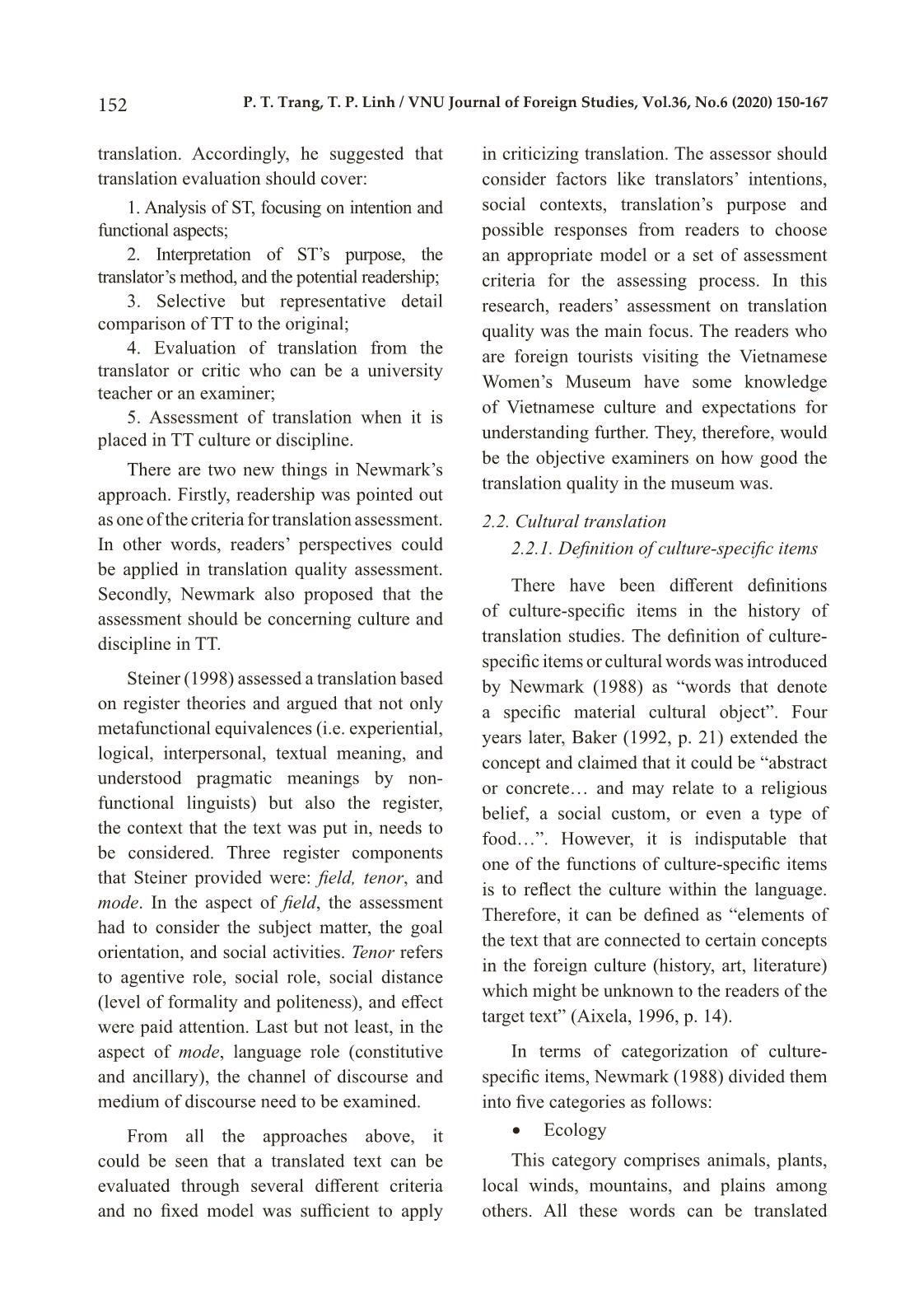
Trang 3
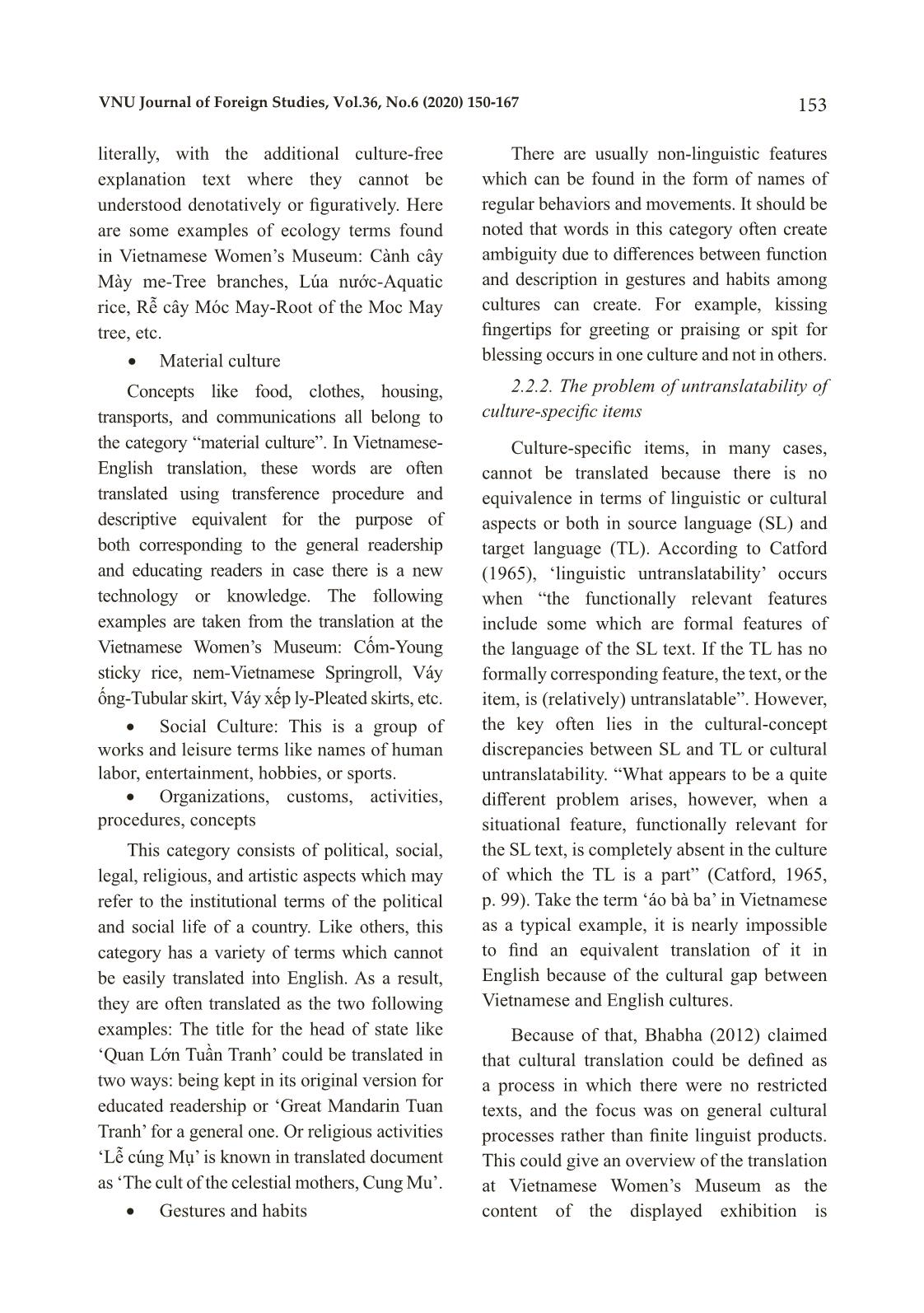
Trang 4
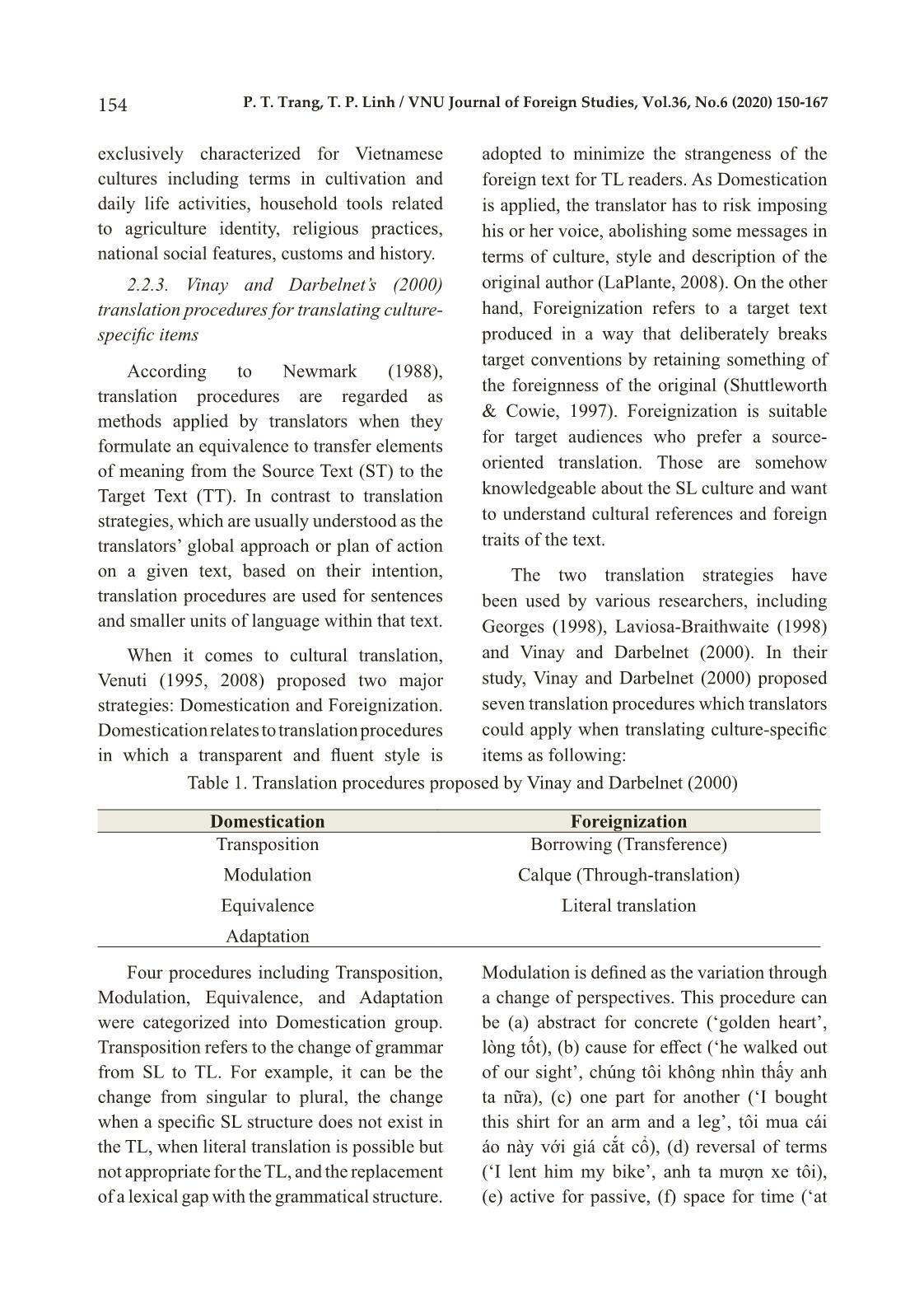
Trang 5
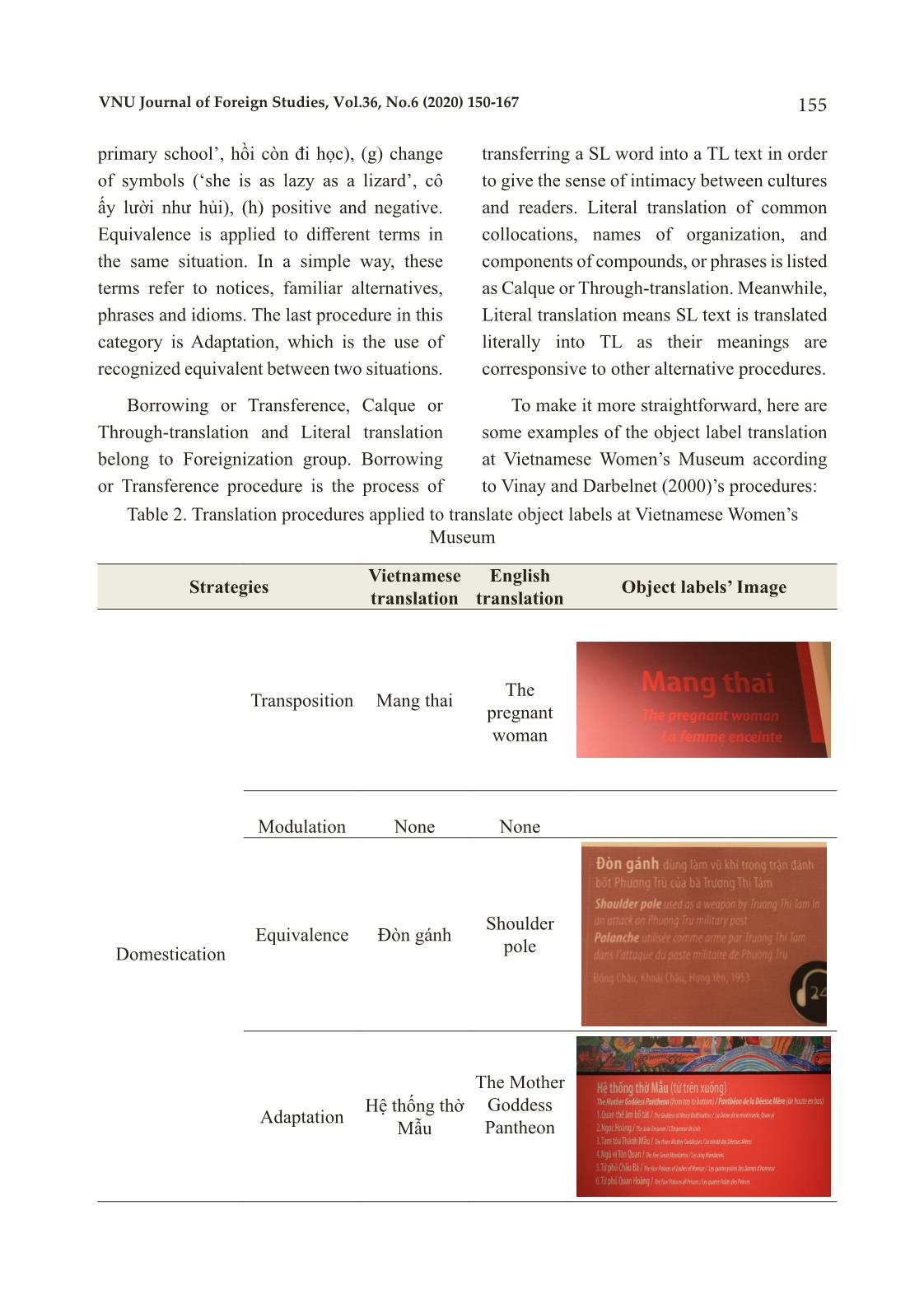
Trang 6

Trang 7
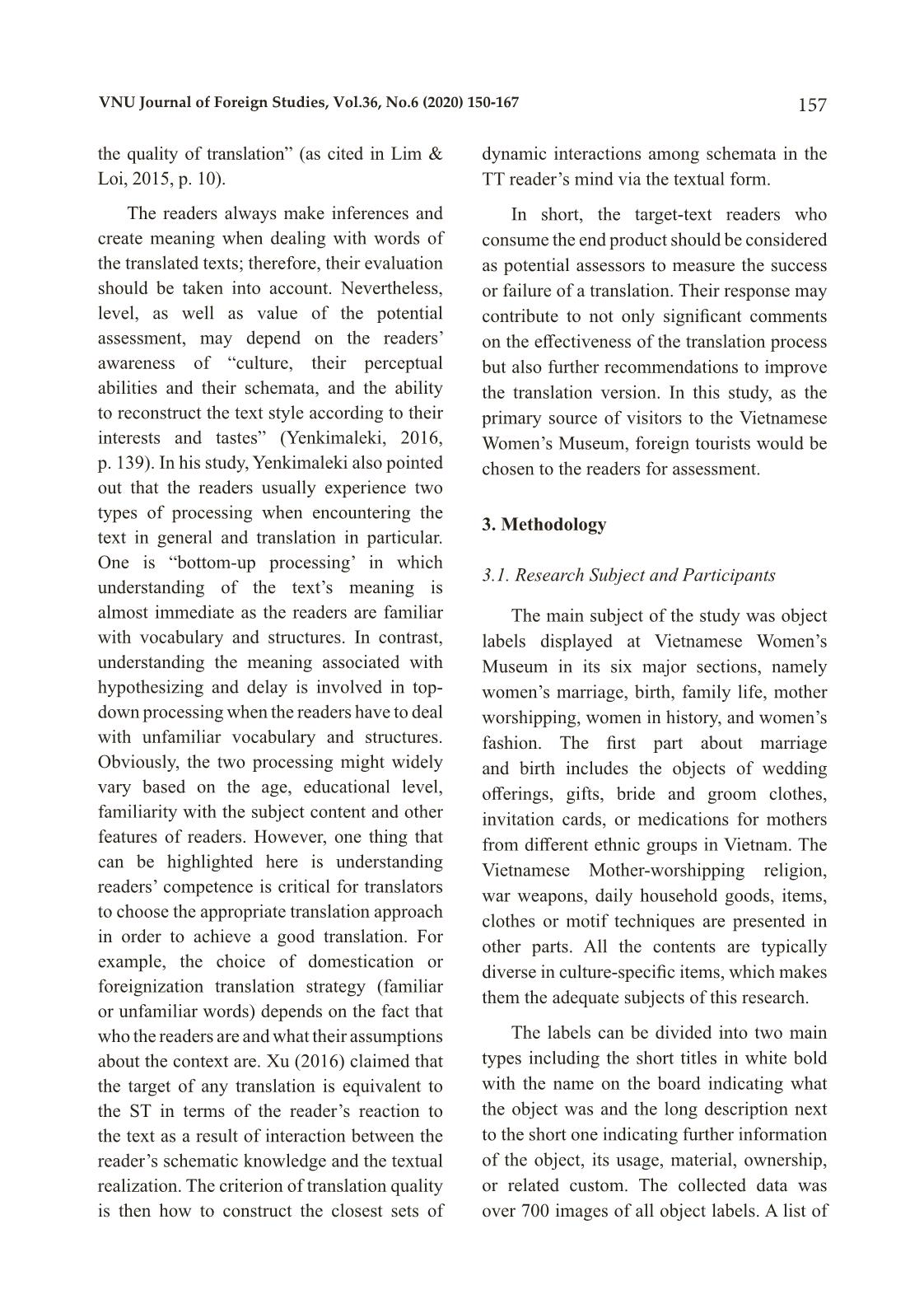
Trang 8
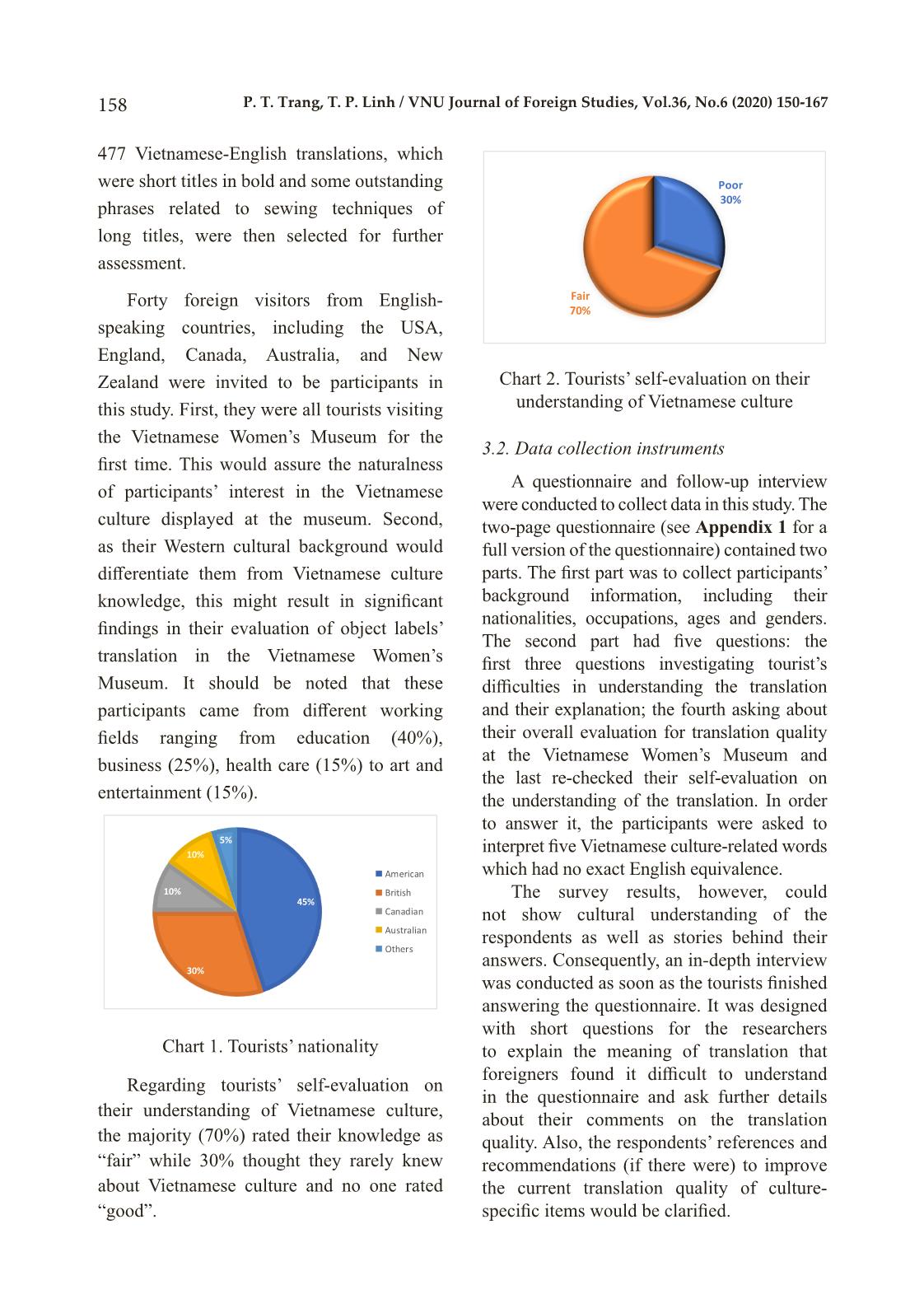
Trang 9
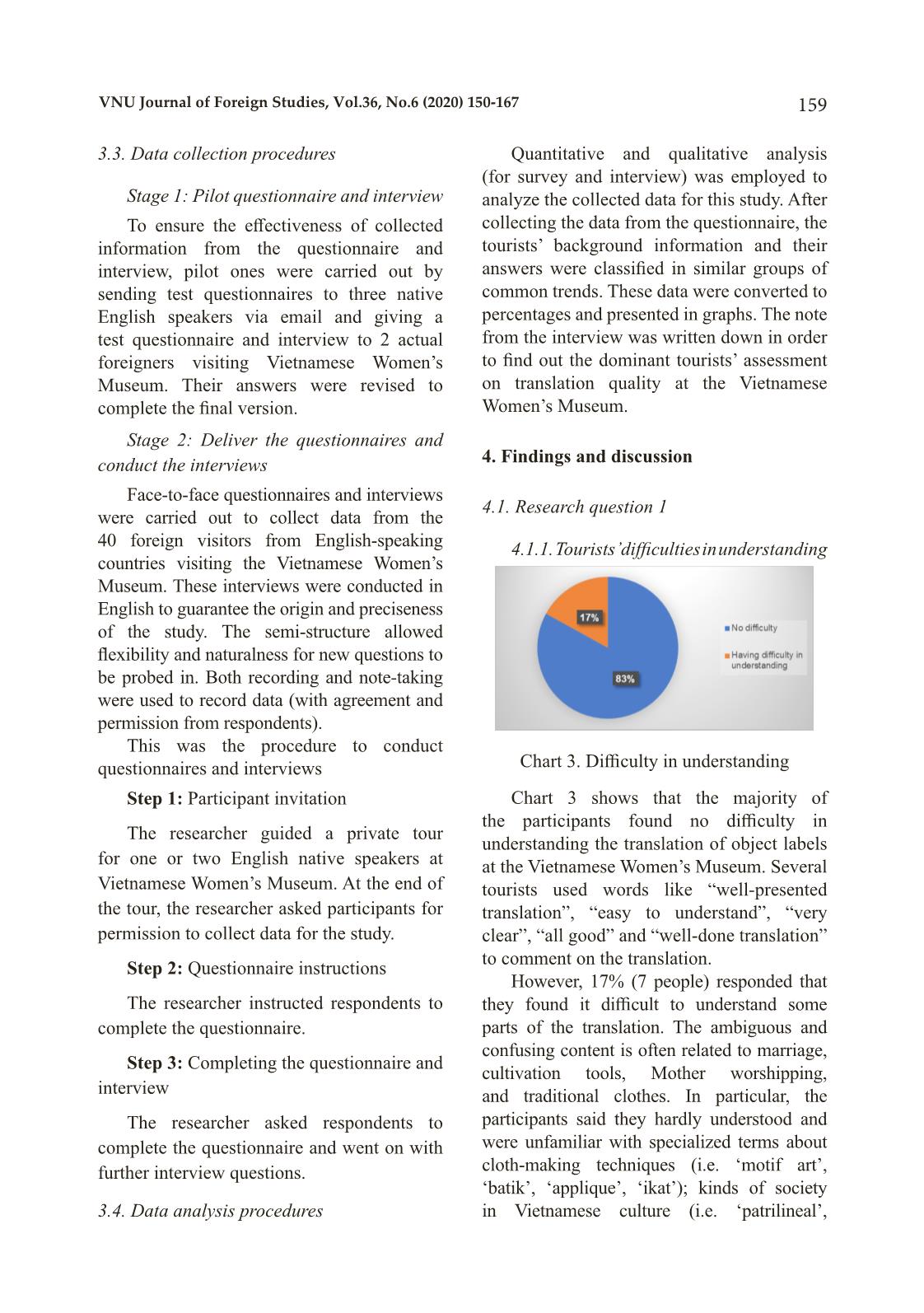
Trang 10
Tải về để xem bản đầy đủ
Tóm tắt nội dung tài liệu: Assessment on Vietnamese-English translation of object labels at Vietnamese women’s museum through foreign tourists’ perspectives
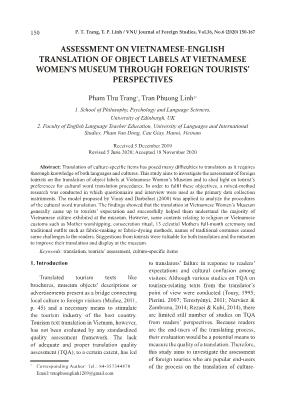
ve equivalence was unavoidable” as descriptive translation could maintain the ‘culture value’ and help them visualize the object. Finally, the tourists did not recognize any differences between literal translation and transposition. As they did not know Vietnamese, grammar changes in transposition procedure could not be recognized from tourists’ views. Overall, literal translation and descriptive equivalence were the most favored procedures in translating at Vietnamese Women’s Museum. 4.2.2. Tourists’ recommendations When being asked for recommendations for better translation at Vietnamese Women’s Museum (especially the culture-specific items 163VNU Journal of Foreign Studies, Vol.36, No.6 (2020) 150-167 that are difficult to understand), all the tourists had no other way to translate. Their common explanations were that their familiarity with Vietnamese culture might not be wide enough to recognize without seeing models, pictures, or reading descriptions and explanations. Their suggestions, therefore, were to broaden Vietnamese culture through tourist brochures, booklets, guide books, or advertisements. For example, if ‘áo dài’ is one of the most traditional and typical dresses, so it was appropriate to keep its original Vietnamese name. But for ‘áo tứ thân’, the tourists said they had barely or never seen it before in Vietnamese tourist brochures or advertisements, hence, it should be translated in a descriptive way. For example, it is suggested that the term may be translated as ‘áo tứ thân’ - a traditional Vietnamese costume with four panels. 4.3. Discussion and implication As can be seen from the results above, there are some suggestions the researchers have withdrawn from. First of all, in general, translation at Vietnamese Women’s Museum came up to tourists’ expectations and successfully delivered the majority content of the museum to help visitors visualize and make them find Vietnamese culture interesting. However, some contents relating to religion or Vietnamese customs (Mother worshipping, consecration ritual, 13 celestial Mothers full- month ceremony) and traditional outfits (fabric- making or fabric-dyeing methods, names of traditional costumes) caused some difficulties for readers. Hence, the Vietnamese Women’s Museum should pay more attention to the display sections of these contents. It is suggested that explanation texts or the introduction of some religious belief and concept, more information, or English description of Vietnamese names can be added in order to help visitors understand more about the Vietnamese culture. Secondly, Vietnamese culture needs more recognition from foreign visitors. For instance, while most foreigners can recognize traditional costumes’ names from other countries like ‘Hanbok’ from Korean or ‘Kimono’ from Japan, ‘Ao dai’ from Vietnam is hardly retained by tourists unless they have come to Vietnam before. This highlighted that the Vietnamese government or travel agencies should consider spreading images of Vietnamese cultures, including diversity of ethnic minority groups, traditional ceremonies, costumes, cuisines, music, and local customs more internationally. Public media like magazines, advertisements, tourist brochures, handbooks, or social networks can be a useful means in this case. Besides, as these concepts are strange to foreigners from other cultures, they should be introduced informatively and thoroughly in the simple short text so that foreigners can absorb and remember with ease. Last but not least, when the translators want to keep the origin of Vietnamese names, added explanations in English should appear apart from Vietnamese version in order to make readers memorize the content. 5. Conclusion The study revealed that most tourists (83%), despite their different gender, background, or nationality, found no difficulty in understanding translated terms and no tourists felt ‘dissatisfied’ with the translation. On top of that, the response rates were beyond expectation with only positive votes of ‘completely satisfied’ and ‘quite satisfied’. In contrast, when it comes to the negative side, most tourists still had difficulty in understanding some Vietnamese cultural translations relating to religion and national costumes. 164 P. T. Trang, T. P. Linh / VNU Journal of Foreign Studies, Vol.36, No.6 (2020) 150-167 Besides, tourists’ preferences for translation were literal translation, transposition, and descriptive equivalent. They also recommended that literal translation should be mostly used because objects share similar features between cultures; therefore, this procedure is simple to understand with visual supports like models or pictures of objects. For Vietnamese culture-specific items that cannot be translated literally, the descriptive equivalent would be helpful for readers to visualize the object. Furthermore, the tourists suggested more detailed explanations for some Vietnamese culture- bound terms as well as wishes for Vietnamese culture to become more popular and advertised in public media. This, to some extent, helps foreigners assess Vietnamese culture easier so that the chance for them to understand cultural translation would be enhanced. In terms of limitation, this study was conducted on a small scale (40 foreign visitors) at the Vietnamese Women’ Museum. This can affect the diversity of tourists’ assessment and the result of the study. In addition, the content of the museum covers many aspects and the sizeable exhibitions consist of four floors with smaller sections in various Vietnamese- related areas. Hence, the questionnaires and interviews conducted at the end of the visit can be less qualitative as most tourists cannot remember the difficult translations to understand and their tiredness also made the judgment less precise. When it comes to recommendations for further studies, it should be noted that further study can be conducted on a larger scale with a larger group of tourists and research subjects in order to enhance the reliability and equality of the research. Additionally, the approach of the study can be explored from another point of view, not only the readers’ assessment on the translation of cultural object labels but also from the translators’ perspectives. Last but not least, further research’s subject can be different from object labels at Vietnamese’s Women Museum. It can be another culture- specific translation at different museums. References Bhabha, H. K. (2012). The location of culture. London: Routledge. Catford, J. C. (1965). A linguistic theory of translation. London: Oxford University Press. Crystal, D., & Davy, D. (1969). Investigating English Style. English Languages Series. London, UK: Longman. Georges, L. B. (1998). Encyclopedia of Translation Studies. New York, NY: Routledge. Hickey, L. (2003). The reader as translation assessor. Studies in Translation, 1(1): 59-92. House, J. (1977). A Model for Translation Quality Assessment. New York, NY: Routledge. Joos, M. (1967). The Five clocks. New York, NY: Harcourt, Brace & World. Laviosa-Braithwaite, S. (1998). Encyclopedia of Translation Studies. New York, NY: Routledge. Lim, L., & Loi, K. (2015). Evaluating slogan translation from the readers’ perspective: A case study of Macao. Babel, 61(2). 283-303. Muñoz, I. D. (2011). Tourist translations as a mediation tool: Misunderstandings and difficulties. Cadernos de traduçao, 1(27), 29-49. Narváez, I. C., & Zambrana, J. M. V. (2014). How to translate culture-specific items: A case study of tourist promotion campaign by Turespaña. The Journal of Specialised Translation, 21, 71-112. Newmark, P. (1988). A Textbook of Translation (Vol 1). New York, NY: Prentice Hall. Nida, E., & Taber, C. (1974). The Theory and Practice of Translation. California: Stanford University Press. Nida, E. (1964). Toward a Science of Translating with Special Reference to Principles and Procedures Involved in Bible Translation. Brill: Leiden. Nida, E. A. (2001). Language and culture: Contexts in translating. Shanghai: Shanghai Foreign Language Education Press. Pierini, P. (2007). Quality in web translation: An investigation into UK and Italian tourism web sites. The Journal of Specialised Translation, 8, 85-103. Pinto, M. (2001). Quality factors in documentary translation. Meta, 46(2), 288-300. Rezaei, M., & Kuhi, D. (2014). Strategies Employed in 165VNU Journal of Foreign Studies, Vol.36, No.6 (2020) 150-167 Translation of Tourist Guidebooks Culture-specific Items from Persian into English. Theory & Practice in Language Studies, 4(4), 750-757. Shuttleworth, M., & Cowie, M. (1997). Dictionary of Translation Studies. Manchester, UK: St Jerome Publishing. Steiner, E. (1988). The Concept of Register and the Evaluation of Translation. Amsterdam: John Benjamins. Steiner, G. (1975). After Babel. London: Oxford University Press. Terestyényi, E. (2011). Translating culture-specific items in tourism brochures. SKASE Journal of Translation and Interpretation, 5(2), 13-22. Toury, G. (1995). Descriptive Translation Studies and Beyond. Amsterdam/Philadelphia: John Benjamins. Venuti, L. (1995). The Translator’s Invisibility. New York, NY: Routledge. Venuti, L. (2008). The Translator’s Invisibility: A History of Translation. New York, NY: Routledge. Vinay, J. P., & Darbelnet, J. (2000). A methodology for translation. In L. Venuti (Ed.), The Translation studies reader (pp. 84-94). London, UK: Routledge. Wenger, L. (1981). Glossary of Terms Used in the Management of Quality (5th ed.). Berne: European Organization for Quality Control. Xu, Z. (2016). Translation Equivalence and the Reader’s Response. International Review of Social Sciences and Humanities 10(2), 98-109. Yenkimaleki, M. (2016). Stepping into others’ shoes: the readership taste in translation. Journal of Linguistic and Intercultural Education, 9(1), 139-149. ĐÁNH GIÁ VỀ BẢN DỊCH VIỆT-ANH CÁC MẪU VẬT Ở BẢO TÀNG PHỤ NỮ VIỆT NAM QUA GÓC NHÌN CỦA DU KHÁCH NƯỚC NGOÀI Phạm Thu Trang1, Trần Phương Linh2 1. Khoa Triết học, Tâm lý và Khoa học ngôn ngữ, trường Đại học Edinburgh, Vương quốc Anh 2. Khoa Sư phạm tiếng Anh, trường Đại học Ngoại ngữ, ĐHQGHN Phạm Văn Đồng, Cầu Giấy, Hà Nội, Việt Nam Tóm tắt: Dịch từ ngữ văn hóa gây ra nhiều khó khăn cho người dịch vì công việc này đòi hỏi kiến thức sâu rộng về cả ngôn ngữ và văn hóa. Nghiên cứu này nhằm nghiên cứu đánh giá của khách du lịch về bản dịch thuật các mẫu vật tại Bảo tàng Phụ nữ Việt Nam và làm sáng tỏ các ưu tiên của khách du lịch đối với các thủ pháp dịch từ văn hóa. Nhằm hoàn thành các mục tiêu này, một nghiên cứu hỗn hợp đã được thực hiện, trong đó phương pháp điều tra qua bảng hỏi và phỏng vấn đã được sử dụng làm công cụ thu thập dữ liệu chính. Mô hình đề xuất của Vinay và Darbelnet (2000) được sử dụng để phân tích các quy trình dịch thuật được áp dụng trong việc dịch các từ văn hóa. Kết quả nghiên cứu cho thấy nhìn chung bản dịch tại Bảo tàng Phụ nữ Việt Nam đã đáp ứng kỳ vọng và truyền tải thành công phần lớn nội dung, giúp du khách hiểu đa phần nội dung văn hóa được trưng bày tại Bảo tàng. Tuy nhiên, một số nội dung liên quan đến tôn giáo hoặc phong tục ở Việt Nam bao gồm thờ Mẫu, lễ bán khoán, tục cúng Mụ (cúng đầy tháng) và trang phục truyền thống như phương thức may hoặc nhuộm vải, tên trang phục truyền thống) gây ra một số khó khăn cho độc giả. Các đề xuất từ khách du lịch có giá trị cho cả người dịch và Bảo tàng để cải thiện bản dịch và phần trưng bày tại Bảo tàng. Từ khóa: dịch thuật, đánh giá của khách du lịch, thuật ngữ văn hóa. 166 P. T. Trang, T. P. Linh / VNU Journal of Foreign Studies, Vol.36, No.6 (2020) 150-167 APPENDICES Appendix 1: Questionnaire We are a research team from University of Languages and International Studies. We are carrying this survey to collect data for our research “ASSESSMENT ON VIETNAMESE- ENGLISH TRANSLATION OF OBJECT LABELS AT VIETNAMESE WOMEN’S MUSEUM THROUGH FOREIGN TOURISTS’ PERSPECTIVES” We would be very grateful if you could complete this questionnaire. The information will be used for research purposes only. Thank you for your contribution! A. Participant’s background Nationality: Gender:. Occupation: Age:. B. Translation Assessment 1. In which area of VWM do you find difficult to understand the translating label? (You can choose more than one or none) a. Labels related to marriage custom b. Labels related to birth custom c. Labels related to women in history d. Labels related to traditional clothes e. Labels related to family items f. Labels related to mother worshipping g. Labels related to cultivation tools 2. Can you give examples of some translating labels at the museum that you do not understand? ........................................................................ .................................................................................................................................................... .................................................................................................................................................... 3. What do you think about translation quality at Vietnamese Women’s Museum? 4. What is your general understanding of Vietnamese culture? 167VNU Journal of Foreign Studies, Vol.36, No.6 (2020) 150-167 a. Good b. Fair c. Poor 5. How you interpret the phrases below: a. Celestial mother: b. Consecration ritual: c. Mother Goddess: d. Shoulder pole: e. Ao dai: 6. From the scale of 1 to 10, please indicate the level of content of the museum translation that you can understand with ease. This is the end of the questionnaire! If you are interested in my research or have any questions, do not hesitate to contact me via tranphuonglinh1209@gmail.com. Thank you for your time! Appendix 2: Interview Part A: Tourists’ assessment 1. Can you explain your answer to question 1? If there is difficulty, can you name the particular factors that make you feel difficult in understanding this field? 2. (Explain the meaning of difficult understanding items in question 2 and 5 for participants). After understanding the label(s), do you have any recommendations for better translation? 3. What is your general opinion about Vietnamese-English translation of object labels at VWM? Part B: Tourists’ preference 1. What way of translating in the museum do you like best? (Given the table of classified labels based on different procedures and strategies) If you are not satisfied with the translation, do you have any suggestions or preference for better translation?
File đính kèm:
 assessment_on_vietnamese_english_translation_of_object_label.pdf
assessment_on_vietnamese_english_translation_of_object_label.pdf

